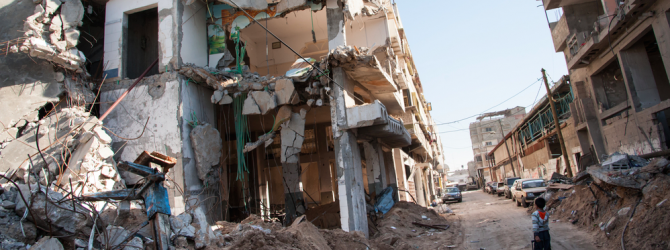-
On The One Year Anniversary of The Ceasefire in Gaza, Dr ...
On The One Year Anniversary of The Ceasefire in Gaza, Dr Erica Harper Reflects on The Events of Last Summer

The 26th of August 2015 marks one year since the 51-day military assault on the Gaza Strip that left 2251 Palestinians dead, 551 of them children.
In the October following the ceasefire, the international community met in Cairo and pledged USD 5.4 billion for reconstruction. By February of this year, only five percent of this had been collected, and by July UNRWA had received enough funds to rebuild only 200 of the 7,000 demolished homes the organization had committed to rebuild. Some 100,000 Gazans remain homeless. At the current rate, Oxfam has estimated that reconstruction will take a century to complete.
With three conflicts in the past seven years, children have grown up under recurrent violence. In Gaza, soaring parental unemployment and homelessness, as well as stilted efforts to repair hospitals and schools have amplified the effect of these traumas. Yet until now, even needed water infrastructure repairs have been on hold.
A major challenge is that Israel controls what goods are allowed into Gaza. According to UK-charity organization, Christian Aid, only one percent of the needed materials have been allowed into the Gaza Strip, with even the most optimistic projections hovering well below ten percent. The modalities established to facilitate reconstruction – including the UN-brokered Gaza Reconstruction Mechanism – seem to overlook what some commentators see as a key paradox: that rebuilding Gaza requires reliance on and cooperation with an entity that is, at best lukewarm, and at worst inimical, to this aim. Whether one accepts Israel’s justification that cement imports may be used to rebuild tunnels, or charges that it is simply punishing Hamas economically, no one can deny that the principal victims are the Gazans themselves.
This situation begs the question of what reconstruction obligations States assume when they take military action – particularly where one party has disproportionate military might or in cases of so-called irregular warfare (when military action takes place without a UN Security Council mandate).
Instigators assuming responsibility for reconstruction has precedent, but these instances are inconsistent and the parties leading the reconstruction often have a strategic interest in play. Examples include where there is a ‘hearts and mind’ element to the military objective such as in the US invasions of Iraq and Afghanistan, or where there is a component of self-interest; in the aftermath of the Balkans war, neither Europe nor Americans wanted to see a conflict relapse that could result in a mass refugee outflow into Europe. Some have opined that the international community was morally obligated to bear the costs of reconstruction following the destruction in Timor Leste in 1999; even though the damage was waged by Indonesia.
Antonia Chayes argues that as the norm of human security gains prominence, there has been a discernible change in ethos towards the obligation to rebuild. In 2001, the International Commission on Intervention and State Sovereignty formulated the concept of Responsibility to Protect. R2P – as it has come to be known – requires the international community to respond to crises of human security and help to end them within the legal framework of the UN Charter. A responsibility to rebuild was “an integral part of this reformulation” until it was omitted when R2P was finally adopted as a norm at the UN World Summit (2005) and subsequently approved by UN Security Council resolution 1674.
Thus, despite precedent, a clear moral basis and evolving consciousness, military interveners are under no legal obligation to rebuild following military intervention. In a context such as Gaza, it seems morally reprehensible that the entity responsible for destruction is able to leave thousands homeless, an economy in ruins and food production capacity severely compromised.
We have opined previously that the nature of warfare has changed so dramatically that the international architecture is rapidly becoming obsolete. The issue of armed non-state actors, the internationalization of conflicts with unclear borders, and the increasing rates of military action taken outside of the UN Charter are all reminders that the laws of war fail to protect its principal victims. Perhaps it is time to add to this list the issue of responsibility for post-conflict reconstruction. As the experiences in Iraq and Afghanistan attest, the manner in which reconstruction is undertaken has a profound impact on the governing authority’s legitimacy and popular content. Reconstruction is also key to all dimensions of a recovering economy. Given the empirically well established links between economic recovery and conflict relapse, this is an issue to which the international community should prioritize.
Earlier this year, His Royal Highness Prince El Hassan bin Talal argued that the effectiveness of the international justice architecture is contingent upon a culture of communication based on a shared understanding. This language has evolved not based on a narrow legal interpretation of human rights, but through a broader commitment to humanitarian rights. He called for the scope of international law to be broadened to include a ‘Law of Peace’, which would contain a set of laws directly related to human welfare, including an obligation for reconstruction. “We spend a lot of our time and resources in discussing how to wage war,” HRH said. Instead, “Now, more than ever, we need to talk about how we are going to wage peace.”

